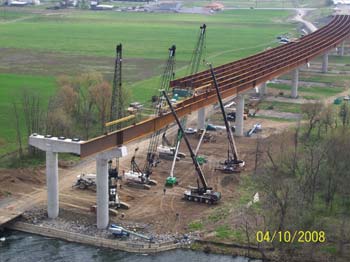
On certain days, you just stop, says Matt Farley, the divisions structure operations Engineer. The day he was interviewed was one of those days, with wind clocked at 40 mph.
To mitigate some of the down time, Farley says V&G and the state highway department have been innovative. One example: Farley is seeking to Slipform the bridges barrier rail, which contains an architectural design. Not having to form and pour the rail by hand will save a good month and a half, he says.
The continuous steel girder structure will stretch 2,139 feet and carry four lanes of Corridor H traffic across the river on eight spans. Specially embossed piers seven and nine feet in diameter support the structure, which towers 100 feet above the water. Earthen embankments abutting the bridge were previously constructed.
Steel girders that are the structures backbone range in height from seven to 10 feet. They were produced by Carolina Steel in Greensboro, N.C.
Most of the bridgework is positioned above a flood plain. To place the girders across the riverbed itself, V&G crews built a temporary causeway. Formed of 10,000 cu. yds. of rock, the causeway functions as a work platform for an HC165 and two HC110 Terex American lattice-boom crawler cranes, along with a rented 500-ton hydraulic truck crane. Because the river is just four feet deep at that point, a platform barge was not an option.
Begun in October 2006, the project is progressing toward a July 2009 finish. Contracted cost of the bridge is $30.9 million.

